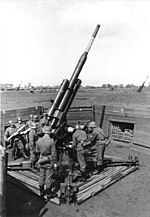Anti-aircraft artillery
Anti-aircraft artillery (abbreviated as AAA; or formerly DCA: Defense Against Aircraft) is a type of artillery, made up of cannons and automatic cannons ( anti-aircraft gun) or machine guns, used as anti-aircraft defense against aviation attacks. These units can be in fixed locations or mounted on towed or self-propelled surface vehicles (including submarines).
History

Anti-aircraft artillery was initially the only means to confront this new military threat. It essentially consists of machine guns or rapid-fire cannons intended for the destruction of aircraft in flight.
Among the conventional cannons were 40 mm caliber models that fired explosive projectiles adjusted to explode at a certain height. The German 88 mm Flak cannon, for example, is a well-known representative of this type of anti-aircraft weaponry (and was also used very successfully against enemy armor).
After the Second World War, the high speed of jet planes meant that these cannons had to reduce their caliber and increase their rate of fire. Advanced detection and control means were also incorporated that allowed fire to be directed by radar or optoelectronic devices. Among these autocannons are the Oerlikon GDF and the Soviet ZSU Shilka.
Currently, anti-aircraft automatic cannon systems are based on intelligent or automated units capable of operating day or night under any weather conditions. Many times they allow remote control, and are kept for the terminal defense of objectives (with effective distances less than 3 km and 1500 m high). Many current anti-aircraft weapon systems comprise combinations of autocannons and short-range anti-aircraft missiles, as in the Tunguska M1 or Pantsir-S1.
Typology
There are several types of anti-aircraft guns, among which the following stand out:
- Them mobile: They are vehicles that incorporate an anti-aircraft cannon and have the possibility to move autonomously, they are also often classified as an auto-propelled anti-aircraft cannon. However, it is possible to include those who are given mobility manually and are pushed by soldiers as a car, thanks to the wheels they possess, such as Type 55 raa-6.
Some other examples may be M163 A1 or ZSU-23-4.
- Them fixed: are those who are fixed to the ground and the only thing that has mobility is the cannon, turning side by side, up or down... To move them you need some kind of external traction, trailer vehicles or any other means.
Some examples are Flak 88 or 76/C Mk75.
Contenido relacionado
Uranium
Gene
Dactyloctenium



